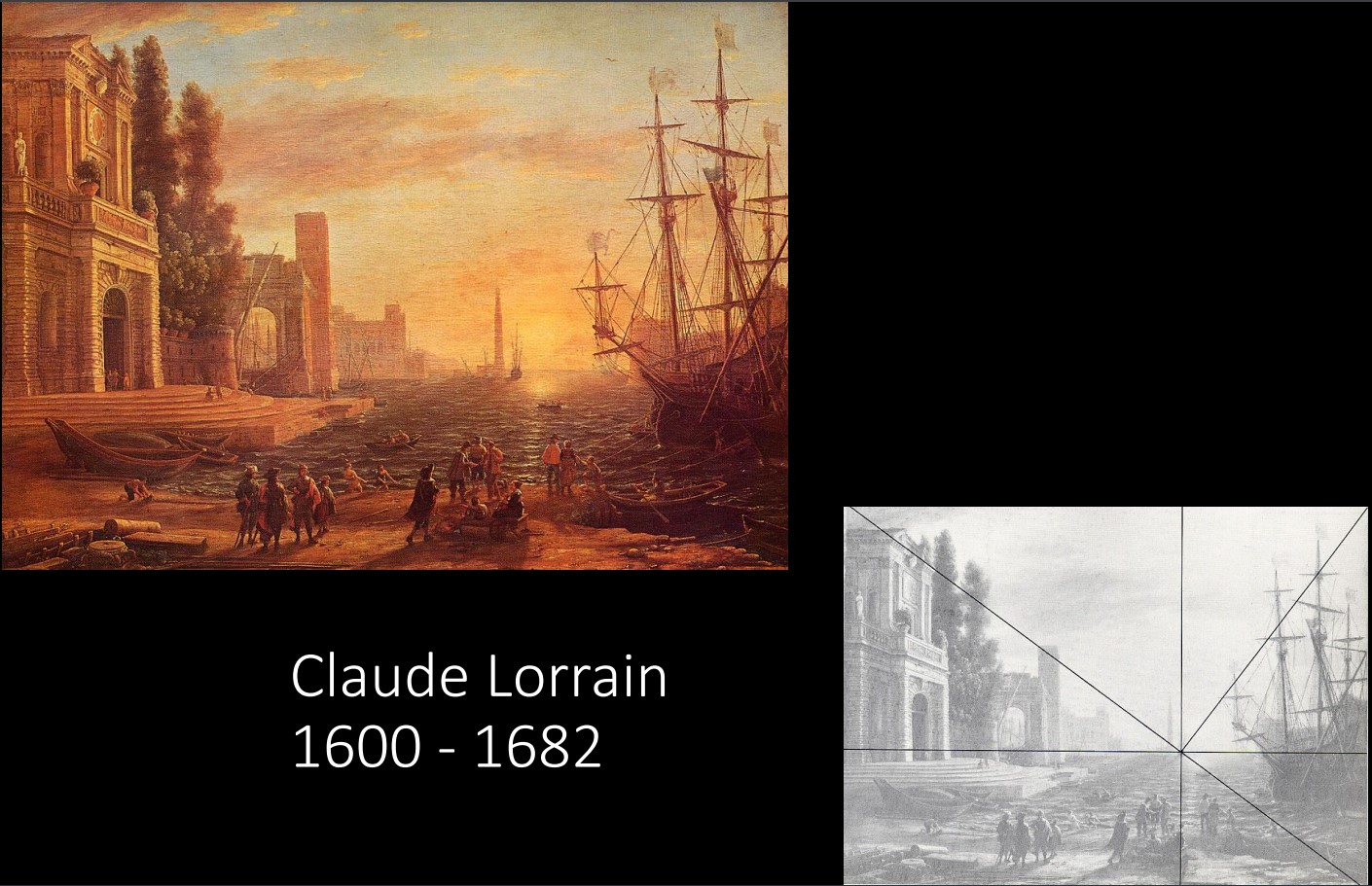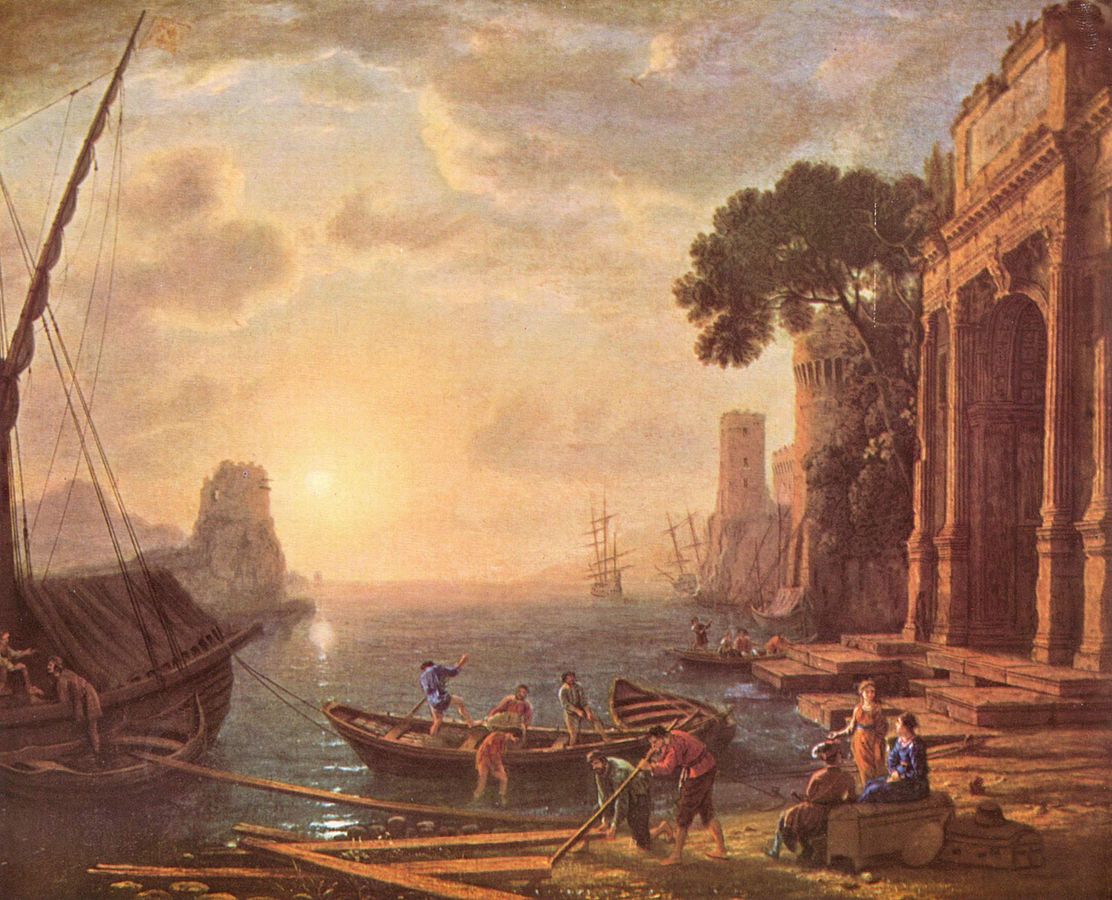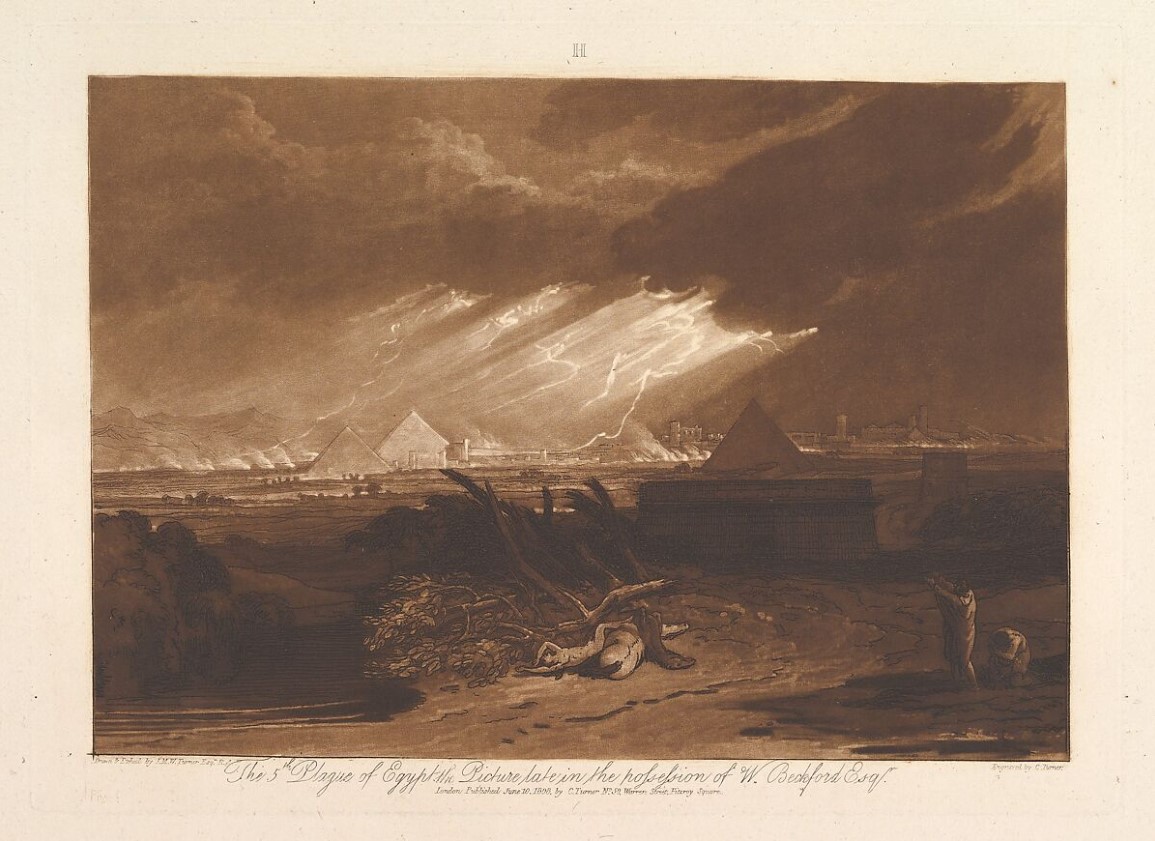
In s2e29, Platemark hosts Ann Shafer and Tru Ludwig talk about Claude Lorrain, the arbiter of landscape painting in the 17th century. He worked most of his life in Rome and elevated landscape as a subject up the academic hierarchy by including small...
In s2e29, Platemark hosts Ann Shafer and Tru Ludwig talk about Claude Lorrain, the arbiter of landscape painting in the 17th century. He worked most of his life in Rome and elevated landscape as a subject up the academic hierarchy by including small figural groups and naming the compositions with mythological or biblical subjects. He’s known by various names that can be confusing. He was born Claude Gelée in the independent duchy of Lorraine, which is why the French call him le Lorrain. The English, who collected his works assiduously and even now have the highest number of his works (by country), refer to him simple as Claude.
He created an amazing cache of ink and wash drawings of each of his painted compositions in a first catalogue raisonné of sorts. He dubbed this book the Liber Veritatis («the book of truth»). Claude told his biographer Filippo Baldinucci that he kept the record as a defense against others passing off his work as theirs. This bound group of drawings was collected and owned by the Dukes of Devonshire from the 1720s until 1957 when it was given to the British Museum (in lieu of estate taxes upon the death of Victor Christian William Cavendish, the 9th Duke of Devonshire).
While Claude died in 1682, his renown in England was enough to prompt the print publisher John Boydell to hire artist Richard Earlom to create prints after the drawings nearly one hundred years after Claude’s death. Two hundred etchings with mezzotint were created between 1774 and 1777, and were published in two volumes as Liber Veritatis. Or, A Collection of Two Hundred Prints, After the Original Designs of Claude le Lorrain, in the Collection of His Grace the Duke of Devonshire, Executed by Richard Earlom, in the Manner and Taste of the Drawings.... Later, a third volume of an additional 100 prints was published in 1819.
Earlom used etching to mimic Claude’s ink lines and mezzotint for the wash areas. They were printed in brown ink to mimic iron gall ink. Hugely influential in England, the books were popular with collectors and were used by artists as models for copying. The Liber Veritatis also inspired J.M.W. Turner to produce a similar project of 71 prints after Turner’s painted compositions, which he called Liber Studiorum.
They may appear old fashioned to contemporary viewers, but rest assured, landscape was just getting its legs under it. Boring imagery? Maybe. But important for our story of the history of prints in the West.
Episode image: Claude Lorrain (French, c. 1600–1682). Seaport with Ulysses Returning Chryseis to Her Father, c. 1644. Pen and brown ink with brown and blue wash, heightened with white on blue paper. 19.8 x 26.2 cm. British Museum, London.
Gian Lorenzo Bernini (Italian, 1598–1680). Bust of Louis XIV, 1665. Marble. Palace of Versailles.
Hyacinth Rigaud (French, 1659–1743). Louis VIX, 1700–01. Oil on canvas. 277 x 194 cm. (109 x 76 3/8 in.) The Louvre, Paris.
Claude Mellan (French, 1598–1688). Louis XIV as a Child, 1618–1688. Engraving. Sheet (trimmed to platemark): 13 9/16 x 9 1/2 in. (34.5 x 24.2 cm.). Metropolitan Museum of Art, New York.
Federico Barocci (Italian, 1528–1612). The Stigmatization of St. Francis, after the painting in the Church of the Capuccines, Urbino, c. 1575. Etching, engraving, and drypoint. Plate: 228 x 145 mm. (9 x 5 ¾ in.). Achenbach Foundation for Graphic Arts, Fine Arts Museum of San Francisco.
Federico Barocci (Italian, 1528–1612). The Annunciation, c. 1585. Etching and engraving. Sheet (trimmed within platemark): 17 3/8 × 12 5/16 in. (441 × 312 mm.). Metropolitan Museum of Art, New York.
Rembrandt (Dutch, 1606–1669). Christ Crucified between the Two Thieves: The Three Crosses (iv/iv state), c. 1660. Drypoint. Sheet (trimmed to platemark): 15 1/16 x 17 1/2 in. (382 x 444 mm.). Metropolitan Museum of Art, New York.
Annibale Carracci (Italian, c. 1557–c. 1642). St. Jerome in the Wilderness, c. 1591. Etching and engraving. Sheet (trimmed to platemark) : 24.8 x 19.2 cm. (9 ¾ x 7 9/16 in.). Metropolitan Museum of Art, New York.
Guido Reni (Italian, 1575–1642). The Holy Family, c. 1595–1600. Etching and engraving. Sheet (trimmed to platemark): 20 x 14 cm. (7 7/8 x 5 12 in.). Metropolitan Museum of Art, New York.
Jusepe de Ribera (Spanish, 1591–1652). The Penitence of St. Peter. 1621. Etching and engraving. Sheet (trimmed to platemark): 31.8 x 24.2 cm. (12 ½ x 9 ½ in.). Metropolitan Museum of Art, New York.
Salvator Rosa (Italian, 1615–1673). Jason and the Dragon, 1663–64. Etching and drypoint. Plate: 13 5/16 × 8 9/16 in. (33.8 × 21.8 cm.); sheet: 14 5/16 × 9 15/16 in. (36.4 × 25.3 cm.). Metropolitan Museum of Art, New York.
Gian Lorenzo Bernini (Italian, 1598–1680). The Ecstasy of Saint Teresa, 1647-52. White marble set in an elevated aedicule in the Cornaro Chapel, Santa Maria della Vittoria, Rome.
Caravaggio (Italian, 1571–1610). Conversion of Saint Paul on the Way to Damascus, 1600–01. Oil on canvas. 230 × 175 cm. (91 × 69 in.). Santa Maria del Popolo, Rome.
Andrea Pozzo (Italian, 1642–1709). Assumption of St. Francis, c. 1685. Sant’Ignazio, Rome.
Pietro Testa (Italian, 1612–1650). The Martyrdom of St. Erasmus, c. 1630. Etching. Sheet: (trimmed to platemark): 27.9 x 18.9 cm. (11 7 7/16 in.). Metropolitan Museum of Art, New York.
Jacques Callot (French, 1592–1635). Plate eleven: The Hanging from the series The Large Miseries and Misfortunes of War, 1633. Etching. Sheet: 4 1/8 x 8 1/4 in. (10.5 x 21 cm.); plate: 3 1/4 x 7 5/16 in. (8.2 x 18.6 cm.). Metropolitan Museum of Art, New York.
Peter Paul Rubens (Flemish, 1577–1640). The Consequences of War, 1637–38. Oil on canvas mounted to panel. 206 x 342 cm. (81 x 134 ½ in.). Palazzo Pitti, Florence.
Diego Velasquez (Spanish, 1599–1660). Surrender at Breda, 1634–35. Oil on canvas. 307 x 367 cm. (121 x 144 in.) Museo del Prado, Madrid.
Callot’s Hanging Tree spreads word of the facts of the attack on Nancy, whereas paintings can only be in one place (Rubens’ Consequences of War and Velasquez’s Surrender at Breda).
Jean Marot (French, 1619–1679), after Gian Lorenzo Bernini (Italian, 1598–1680). The Louvre in Paris, elevation of the principal facade facing Saint-Germain l'Auxerrois. Plate 8 from Jacques-François Blondel’s Architecture françoise, volume 4, book 6.
Nicolas Poussin (French, 1594–1665). Et in Arcadia ego, 1637–38. Oil on canvas. 85 × 121 cm. (34 1/4 × 47 1/4 in.). Louvre, Paris.
Nicolas Poussin (French, 1594–1665). Landscape with St. John Patmos, 1640. Oil on canvas. 100.3 × 136.4 cm (39 1/2 × 53 5/8 in.). Art Institute of Chicago, Chicago.
Nicolas Poussin (French, 1594–1665). The Abduction of the Sabine Women, c. 1633–34. Oil on canvas. 60 7/8 x 82 5/8 in. (154.6 x 209.9 cm.). Metropolitan Museum of Art, New York.
Rembrandt van Rijn (Dutch, 1606–1669). Landscape with the Good Samaritan, 1638. Oil on oak panel. 46.2 × 65.5 cm. (18 × 25 3/4 in.). Czartorynski Museum, Kraków.
Jacob van Ruisdael (Dutch, 1628/1629–1682). View of Haarlem with Bleaching Fields, c. 1670–75. Oil on canvas. 62.2 x 55.2 cm. (24 ½ x 21 ¾ in.). Kunsthaus Zurich, Zurich.
Thomas Cole (American, born England, 1801–1848). Catskill Mountains Landscape, c. 1826. Oil on panel. 15 15/16 x 21 7/8 in. Sheldon Museum, University of Nebraska-Lincoln.
Tru’s diagrams of Poussin’s Et in Arcadia Ego.
Claude Lorrain (French, c. 1600–1682). Self-Portrait. Oil on canvas. Musée des Beaux-Arts de Tours.
Richard Earlom (British, 1743–1822), after Claude Lorrain (French, c. 1600–1682). Frontispiece for the Liber Studiorum, 1777. Plate: 7 x 5 in. New York Public Library.
Claude Lorrain (French, c. 1600–1682). Seaport with the Embarkation of the Queen of Sheba, 1648. Oil on canvas. 149.1 × 196.7 cm. (58 3/4 × 77 1/2 in.). National Gallery, London.
One of many Claude Lorrain paintings with its corresponding diagram.
Several diagrams showing compositional plans according to the Golden Ratio.
Claude Lorrain (French, c. 1600–1682). Rustic Dance, 1637. Oil on canvas. Galleria degli Uffizi, Florence.
Claude Lorrain (French, c. 1600–1682). The Village Boerendans Dance, c. 1637. Etching. 29.7 x 24.1 cm. (11 ¾ x 9 ½ in.). Alamy Stock Photo.
Claude Lorrain (French, c. 1600–1682). Harbor Scene with Rising, 1634. Etching. Sheet: 5 9/16 x 8 1/4 in. (14.1 x 21 cm.); plate: 5 1/8 x 7 13/16 in. (13 x 19.8 cm.). Metropolitan Museum of Art, New York.
Claude Lorrain (French, c. 1600–1682). Harbor Scene with Rising Sun, c. 1649. Oil on canvas. 97 x 119 cm. (38 x 46 ¾ in.). Hermitage Museum, St. Petersburg.
Claude Lorrain (French, c. 1600–1682). Seaport with Ulysses Returning Chryseis to Her Father, c. 1644. Pen and brown ink with brown and blue wash, heightened with white on blue paper. 19.8 x 26.2 cm. British Museum, London.
Claude Lorrain (French, c. 1600–1682). Seaport with Ulysses Returning Chryseis to Her Father, 1650s. Oil on canvas. 119 x 150 cm (46 ¾ x 59 in.). Louvre, Paris.
Claude Lorrain (French, c. 1600–1682). Landscape wirth Aeneas at Delos, c. 1672. Pen and brown ink and brown wash, with gray-brown wash. 19.3 x 25.6 cm. British Museum, London.
Claude Lorrain (French, c. 1600–1682). Landscape with Aeneas at Delos, 1672. Oil on canvas. 99.6 x 134.3 cm. National Gallery, London.
Claude Lorrain (French, c. 1600–1682). Index of owners of Claude’s paintings in the Liber Veritatis. British Museum, London.
Richard Earlom (British, 1743–1822), after Claude Lorrain (French, c. 1600–1682). Holy Family, from the Liber Veritatis, 1776. Etching and aquatint. Sheet : 23 x 29.4 cm.; plate: 20.8 x 26.3 cm. Pushkin State Museum of Fine Arts, Moscow.
Richard Earlom (British, 1743–1822), after Claude Lorrain (French, c. 1600–1682), published by John Boydell (British, 1719–1804). Liber veritatis: or, A collection of prints, after the original designs of Claude le Lorrain ; in the collection of His Grace the Duke of Devonshire, 1777–1819. New York Public Library, New York.
John Boydell (British, 1719–1804), publisher. Dedication from Liber veritatis: or, A collection of prints, after the original designs of Claude le Lorrain ; in the collection of His Grace the Duke of Devonshire, 1777–1819. New York Public Library, New York.
James Mallord William Turner (British, 1775–1851). Fifth Plague of Egypt, from the Liber Studiorum, part III, plate 16), 1808. Etching only (before first state). Plate: 7 x 10 in. (17.8 x 25.4 cm.); sheet: 8 1/8 x 25 in. (20.6 x 63.5 cm.). Metropolitan Museum of Art, New York.
James Mallord William Turner (British, 1775–1851) and Charles Turner (British, 1774–1857). Fifth Plague of Egypt, from the Liber Studiorum, part III, plate 16), 1808. Etching and mezzotint (first state of three). Plate: 7 1/16 x 10 1/4 in. (17.9 x 26 cm.); sheet: 8 1/4 x 11 7/16 in. (21 x 29.1 cm.). Metropolitan Museum of Art, New York.
Claude Glass. Science Museum, London.
Richard Earlom (British, 1743–1822), after Claude Lorrain (French, c. 1600–1682), published by John Boydell (British, 1719–1804). No. 154 from Liber veritatis: or, A collection of prints, after the original designs of Claude le Lorrain ; in the collection of His Grace the Duke of Devonshire, 1777–1819. New York Public Library, New York.
Richard Earlom (British, 1743–1822), after Claude Lorrain (French, c. 1600–1682), published by John Boydell (British, 1719–1804). No. 1 and 2 from Liber veritatis: or, A collection of prints, after the original designs of Claude le Lorrain ; in the collection of His Grace the Duke of Devonshire, 1777–1819. New York Public Library, New York.
Richard Earlom (British, 1743–1822), after Claude Lorrain (French, c. 1600–1682), published by John Boydell (British, 1719–1804). No. 3 and 4 from Liber veritatis: or, A collection of prints, after the original designs of Claude le Lorrain ; in the collection of His Grace the Duke of Devonshire, 1777–1819. New York Public Library, New York.
Richard Earlom (British, 1743–1822), after Claude Lorrain (French, c. 1600–1682), published by John Boydell (British, 1719–1804). No. 13 and 14 from Liber veritatis: or, A collection of prints, after the original designs of Claude le Lorrain ; in the collection of His Grace the Duke of Devonshire, 1777–1819. New York Public Library, New York.
Claude Mellan (French, 1598–1688). Moses Before the Burning Bush, 1663. Engraving. Sheet (trimmed to platemark): 9 7/16 x 13 3/16 in. (24 x 33.5 cm.). Metropolitan Museum of Art, New York.
Golden mean diagram, https://blog.artsper.com/en/a-closer-look/golden-ratio-in-art/.
Platemark is produced by Ann Shafer
Theme music: Michael Diamond
Audio mixing: Dan Fury, Extension Audio
PR and Marketing: Elizabeth Berger, EYB Creates

























































